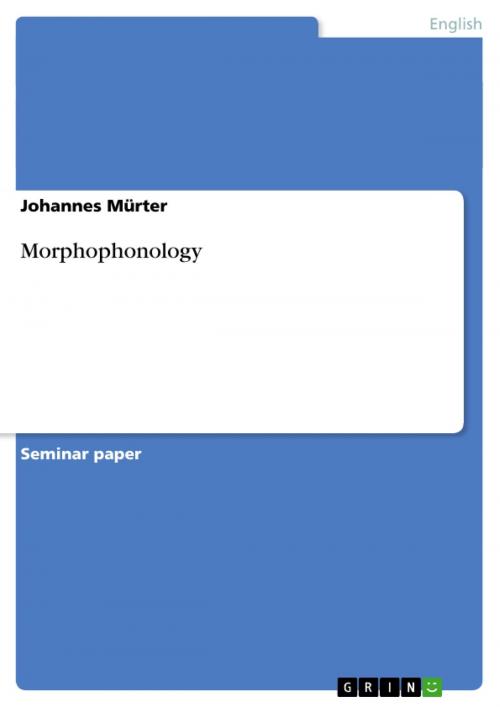| Author: | Johannes Mürter | ISBN: | 9783640512942 |
| Publisher: | GRIN Publishing | Publication: | January 18, 2010 |
| Imprint: | GRIN Publishing | Language: | English |
| Author: | Johannes Mürter |
| ISBN: | 9783640512942 |
| Publisher: | GRIN Publishing |
| Publication: | January 18, 2010 |
| Imprint: | GRIN Publishing |
| Language: | English |
Seminar paper from the year 2009 in the subject English Language and Literature Studies - Linguistics, grade: 1,7, LMU Munich (Institut für Englische Philologie), course: Proseminar 'Morphology', language: English, abstract: In simplest terms, Morphophonology is the branch of linguistic theory which studies how allomorphs are phonologically represented. The question whether this particular subject should best be analysed as part of phonological or morphological theory seems in this respect irrelevant, as Morphophonology can be regarded as an interface between these two branches of linguistics and thus, regarding informative value, can be viewed equally well from either perspective (Kortmann 2005: 89). Later, I will address the issue of congruency, i.e. whether Morphophonology can be regarded as a separate sub-field of linguistics with independent theoretical properties and rules or rather as a merger between phonology and morphology. The latter point of view obviously begs the question whether morphological rules subsequently affect pronounciation or whether phonological properties determine not only the use of, but what is more, the need for allomorphs or in other words, whether, in terms of allomorphy, morphology precedes phonology or the other way around. The aim of this paper is to present the different approaches to allomorphy as regards its phonological implications. After introducing the most important morphophonological rules of the English language, I will proceed to analysing the 'Underlying Representations' on which these rules are based. Thus, following the theories first presented by Noam Chomsky and Morris Halle , I will focus on the psycholinguistic aspect of the URs as well as certain phenomena such as the so called 'Trisyllabic Laxing' and sound changes or stress shifts conditioned by certain suffixes. The gigantic scope of Chomsky's work on Universal Grammar makes it impossible to cover all of the aspects of URs as described in SPE, thus I will restrict my description of URs to only a few morphophonological phenomena that I find most fitting for this topic. Lastly, you will be presented with an alternating theory concerning the relation between allomorphy and phonology, namely Paul Kiparsky's theory of Lexical Phonology , which postulates that an allomorph whose pronounciation in a certain morphological environment cannot be phonologically defined must be listed lexically (Spencer 1991: 118).
Seminar paper from the year 2009 in the subject English Language and Literature Studies - Linguistics, grade: 1,7, LMU Munich (Institut für Englische Philologie), course: Proseminar 'Morphology', language: English, abstract: In simplest terms, Morphophonology is the branch of linguistic theory which studies how allomorphs are phonologically represented. The question whether this particular subject should best be analysed as part of phonological or morphological theory seems in this respect irrelevant, as Morphophonology can be regarded as an interface between these two branches of linguistics and thus, regarding informative value, can be viewed equally well from either perspective (Kortmann 2005: 89). Later, I will address the issue of congruency, i.e. whether Morphophonology can be regarded as a separate sub-field of linguistics with independent theoretical properties and rules or rather as a merger between phonology and morphology. The latter point of view obviously begs the question whether morphological rules subsequently affect pronounciation or whether phonological properties determine not only the use of, but what is more, the need for allomorphs or in other words, whether, in terms of allomorphy, morphology precedes phonology or the other way around. The aim of this paper is to present the different approaches to allomorphy as regards its phonological implications. After introducing the most important morphophonological rules of the English language, I will proceed to analysing the 'Underlying Representations' on which these rules are based. Thus, following the theories first presented by Noam Chomsky and Morris Halle , I will focus on the psycholinguistic aspect of the URs as well as certain phenomena such as the so called 'Trisyllabic Laxing' and sound changes or stress shifts conditioned by certain suffixes. The gigantic scope of Chomsky's work on Universal Grammar makes it impossible to cover all of the aspects of URs as described in SPE, thus I will restrict my description of URs to only a few morphophonological phenomena that I find most fitting for this topic. Lastly, you will be presented with an alternating theory concerning the relation between allomorphy and phonology, namely Paul Kiparsky's theory of Lexical Phonology , which postulates that an allomorph whose pronounciation in a certain morphological environment cannot be phonologically defined must be listed lexically (Spencer 1991: 118).















